- Offensive Techniques & Strategies
Inbounding the Ball Under Pressure
What to Discover or Recall
Realize that games and championships are lost because teams could not inbound the ball at the end of the game.
Grasp the importance of a good inbounder and that they must be developed.
Learn the basic techniques and principles required to inbound the ball under pressure.
Comprehend that players must be taught and practice the fundamental passing and receiving skills needed for making successful inbounds passes.
Understand that players, on all levels, must know the rules.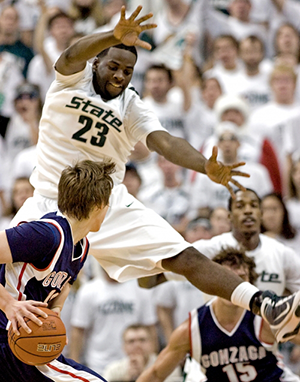
It is not so easy to inbound ball. Most players and coaches take making an inbounds pass for granted, and rely on individual player effort to get the job done. However, in making an inbounds pass, the passer is facing a five against four defensive advantage and only has five (5) seconds in which to locate a receiver and make a successful inbounds pass.
In addition, to this numerical disadvantage, by rule the inbounder cannot move, except after a made shot. This provides the defense with the opportunity to jam or smother the passer very effectively with an active defender on ball. Also, on baseline out of bound situations, the backboard comes into play and becomes a real obstacle in which that the inbounds passer has to contend.
Many of championships have been lost because teams were not able to inbound ball at end of game. Players on all levels, including the NBA and WNBA, need to know and practice the fundamental skills and concepts required in making a successful inbound pass. In additional to the physical skills involved, good inbound passers must possess a strong commitment to team play since they are taken for granted and very rarely rewarded for the efforts. However, good inbounders are vital, and a team will not win a championship without one.
| Inbounding | Automatics | Basics | Receiving | Techniques | Rule Knowledge |

Inbounding the Ball Techniques and Principles

Inbounder must wait for teammates to be aligned and ready before stepping out of bounds.
Call out of bounds plays prior to stepping out of bounds and receiving the ball from the official.
Establish eye contact, and echo the call.
-
See the floor prior to obtaining the ball.
Circle to the official or ball viewing entire court prior to taking it out. Never step out of bounds to inbound the ball with back to the court.
Anticipate, read and attack any defensive overplays and errors.
-
Use sharp, crisp passes.
No careless, one-handed or soft bounce passes.
Pass the ball through, not over, the defender pressuring the inbounds pass.
If defense switches on a screen look for the screener rolling to be open.
Never throw directly at a receiver moving away from you. Always lead the receiver to the basket on lob and baseball passes.
-
Be sure to step inbounds after inbounding the ball.
Create a lead for return pass, establish offensive rebounding position or go to defensive balance.

Automatics
1. If unguarded, inbound the ball and receive the ball back on a basket cut (give & go).
2. When the defender guarding the out of bounds pass turns back, think about passing to self. Throw the ball off the opponent's back, step inbounds, and retrieve it. This can catch the defense completely by surprise and create an easy shot.

Inbounding the Ball Basics
Players on all levels need to be taught and practice the fundamental skills and concepts needed in making a successful inbounds pass. In additional to the physical skills involved, since they are taken for granted and very rarely rewarded for the efforts, inbounders must have a strong commitment to team play . Once a player makes an inbound pass, they are primarily responsible for maintaining defensive balance or usually the last option. However, good inbounders are vital, and you will not win a championship without one.
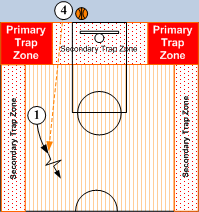
Trap Zones
Avoid inbounding the ball into trap zones. Inbounder must using sharp, crisp passes. Avoid throwing any weak or bounce passes.
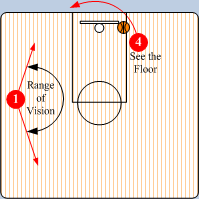
Court Vision
Inbounder O4 must loop and see the floor before gaining possession of the ball and stepping out of bounds.
Outlet O1 should always receives the inbounds pass with back (numbers) to the sideline.
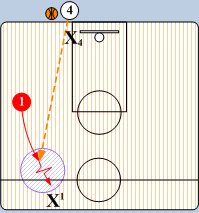
Make Deep Outlets
When inbounding the ball, make as deep as an inbounds pass as the defense will allow. This will cut down the time and court distance needed to advance the basketball in attacking the defense. Also, try to inbound to a player in motion.
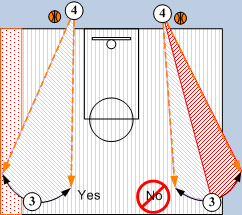
Court Spacing
By setting up to receive a pass 3'- 6' off the sideline, if/when the pass is a little wide the receiver can still step over and successfully catch the ball. On the other hand, it the receiver sets up right on sideline, it eliminates any margin for error. If the pass is a little wide it will result in a turnover for being out of bounds.
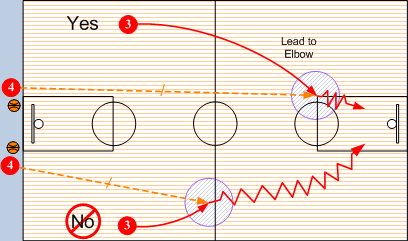

When throwing long, the inbounder passer must take the ball out on one side of the basket or the other to avoid striking it, and must lead the receiver to "Elbow." Never throw a pass directly to a receiver moving away. Since the receiver will be looking back at the ball, the defender can easily establish defensive position resulting in leading the receiver into offensive foul or traveling violation.
Inbounder should employ an "Over the Top" baseball pass or a hook pass. A high arching pass will not only allow the defense to recover, but it, also, may hit an obstruction hanging down from the ceiling such as the scoreboard or speaker. If the pass is thrown too far out in front of the receiver, when it hits the floor, because of the back spin, it will bounce straight up allowing the receiver to catch up and gain possession rather than skipping out of bounds.

Getting Open & Receiving the Inbounds Pass
Basic Guidelines
-
Players not taking the ball out of bounds must immediately set up for an inbounds pass or play.
Never allow the defense to get set up first and gain the advantage.
Cut to basket anytime a defender turns back.
Don't fake out your passer.
Hold a hand up as target for passer to where you want the ball.
Create leads and set up any screens.
Avoid the trap zones.
Reverse or back cut against defensive over play.
After receiving ball assume a strong triple threat position.
See the floor and make sharp, crisp passes.
No one handed or bounce passes.
Do not trap dribble (bounce the ball once).
Be alert for the "you take it out" play.
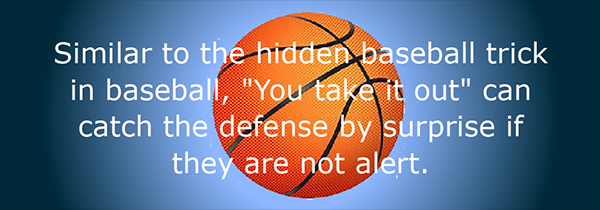
After the official puts the ball in play, the inbounder calls out "(Name of player) you are supposed to take the ball out of bounds." (Name of player) then moves to basket like they are going to take the ball out of bounds, but instead receives an inbounds pass for uncontested shot.

Five Basic Techniques for Inbounding the Ball
Most teams do a poor job of defending baseline and sideline out bounds plays. But, on the other hand, they are very well prepared to deploy a variety of presses to exert full court pressure.
1. Posting Up
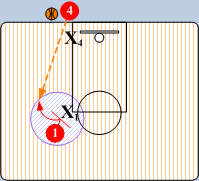
Simple Post Up Move
O1 posts up his defender X1 by creating contact and then using a step over/arm over technique to receive the inbounds pass from O4. Inbounder O4 always passes away from the defender.
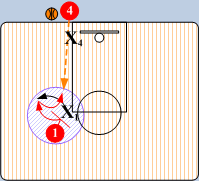
Spin Move
If/when the defensive player X1 counters the step over/arm over move by stepping in the same direction, O1 spins back in the opposite direction to receive the inbounds pass. Inbounder O4 should pump fake and then pass to O1 away from the defense.
2. Over the Top Pass

Over the Top Pass
If/when the defensive player X1 assumes a face position against O1, O1 seals off X1 and releases to the ball after the pass is in the air. Inbounder O4 leads receiver O1 with an over the top pass.
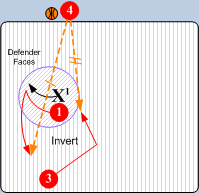
Invert
If/when the defensive player X1 establishes a fronting pass denial position against O1, O3 makes a v-cut into the middle, calling for a pass from 04. O1 then releases against X1's face up denial and looks to receive a quick feed from O3. With O3 cleared out, inbounder O4 also has the option of making an over the top inbounds pass directly to O1.
3. Screen and Roll
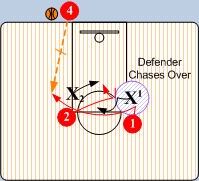
On the initial alignment O1 and O2 set up side by side. O2 then sets a hard screen on defender X1. When defender X1 chases over the screen, O4 looks to make a direct inbounds pass to O1. If defender X1 goes under the screen, O4 looks to make an over the top pass to O1 cutting away from the basket.
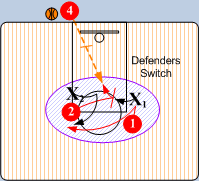
When the defense switches, O4 looks to inbound to O2 rolling to the basket. If the defense anticipates the switch and zones, O2 breaks off the screen and cuts way to basket for an inbounds pass from O4.

Over the Top Pass. When the defenders X1 and X2 face up on O1 and O2, and O4 is unable to make an over the top pass, O4 looks to pass to O3 breaking back into the middle for help. After receiving the inbounds pass, O3 looks to feed O1 or O2 on a speed cut to the basket.
4. Tandem Screen
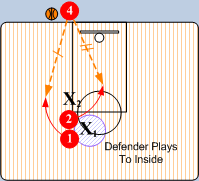
Left Side Tandem Entry
O1 lines up behind O2. If/when defender X1 plays to the inside O1 breaks to the outside. O2 breaks opposite O1. O4 looks to make a sharp inbounds pass to O1 or O2.
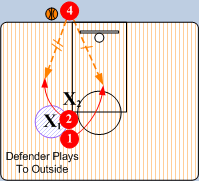
Right Side Tandem Entry
If/when defender X1 plays to the outside of O1, O1 breaks to the inside. O2 breaks opposite O1. O4 looks to make a sharp inbounds pass to O1 or O2.
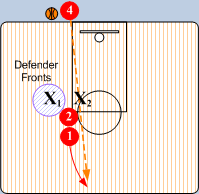
Over the Top Pass. If/when defender plays in front of O1, O4 looks to make a direct over the top pass to O1.
5. Automatic and Double Team Entries
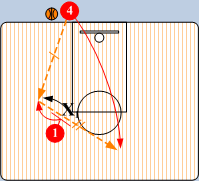
Give & Go
If/when the inbounder is left unguarded, O4 looks to execute the
automatic "Give & Go" option. O4 makes a quick inbounds
pass to O1 and cuts down the middle of the floor. O1 looks to make a quick return pass to O4.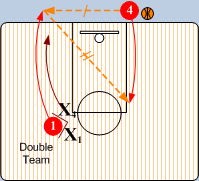
Double Team Entry
When the defense double teams O1, O1 can step out of bounds and receive a pass from O4. O1 then makes a quick return pass to unguarded O4 cutting down the court. Note: If either defender X1 or X4 reaches out and touches O4's pass to O1 behind the out of bounds plane, it is a technical foul.

Out of Bounds Rule Knowledge
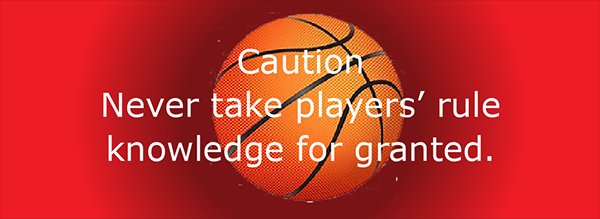
All players must know the rules. A player's lack of rule knowledge cannot only result in a loss of ball possession, but can also cost you a game or championship.
-
The inbounder can not be changed once an official has designated player for throw-in.
On a throw-in the ball must leave the inbounder's hands within five seconds from the time the throw-in starts.
The inbounder cannot touch the ball until it has been touched by another player.
If the defender plays with their back to inbounder, the inbounder can toss the ball off the defender's back and as long as they step inbounds first, pick up ball and score.
For a timeout to be granted during the throw-in, it must be requested before the five second count elapses.
Make sure all players know how many time outs they have left in the game.
Except after a made shot, the inbounder cannot leave the designated throw-in spot. However, they are allowed one step in either direction.
After a made shot, the inbounder can run along the baseline prior to making an inbounds pass.
-
From the front court, the ball can be inbounded to a teammate in the back court without an over and back violation being called.
When the inbounds pass goes directly out of bounds without being touched, it comes back to the original throw-in spot rather than where it goes out of bounds.
When a timeout is called immediately following a made basket, on the subsequent throw-in the inbounder can still move along the baseline.
On the throw-in after a made basket, you do not lose right to run baseline because of an infraction by defense.
For example, if the ball is kicked by a defender on the inbounds pass, the inbounds passer can still run the baseline on subsequent throw-in.
Inbounder can safely pass the ball into the back court without an over and back violation being called.
Inbounder cannot throw ball over the backboard or directly into the basket.
Prior to rule change, teams with a tall player could simply lob the ball over the basket. Coaches would use their creative ingenuity, including hanging chicken wire down from the ceiling behind the basket, to stop out of bounds lob plays.
-
After a made basket, it is legal for the inbounder to pass to a teammate stepping out of bounds along the baseline and receive a return pass after stepping inbounds.
If the defender reaches over the out of bounds vertical plane and touches the ball while in the hands of the inbounder or is in the air behind the vertical plane, it is a technical foul.
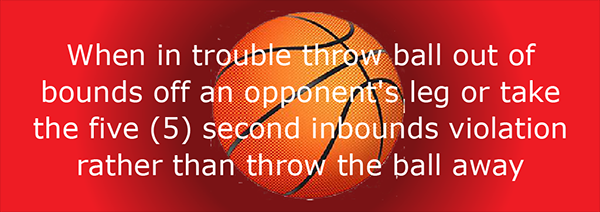
When the ball is turned over on the inbounds pass, it immediately creates a five on four offensive advantage. However, by taking the five (5) second count, it will allow a team to get set on defense and have better than 60% chance of making a defensive stop.
Out of Bounds Rule Knowledge Test
Have your players take this self-quiz. Inbound violations occur even on the NBA level. Use the results as a team evaluation. Go over any question(s) missed by multiple players making sure that all players understand the rule. In taking a few minutes to test your players’ rule knowledge, it may save and even win a game or two.
 Take the HoopTactics' Self-Quiz
Take the HoopTactics' Self-Quiz
Return to Offensive Situations - Click Here
Return to Offensive Strategies - Click Here
Return to HoopTactics - Click Here
© 2026 HoopTactics All Rights Reserved.
